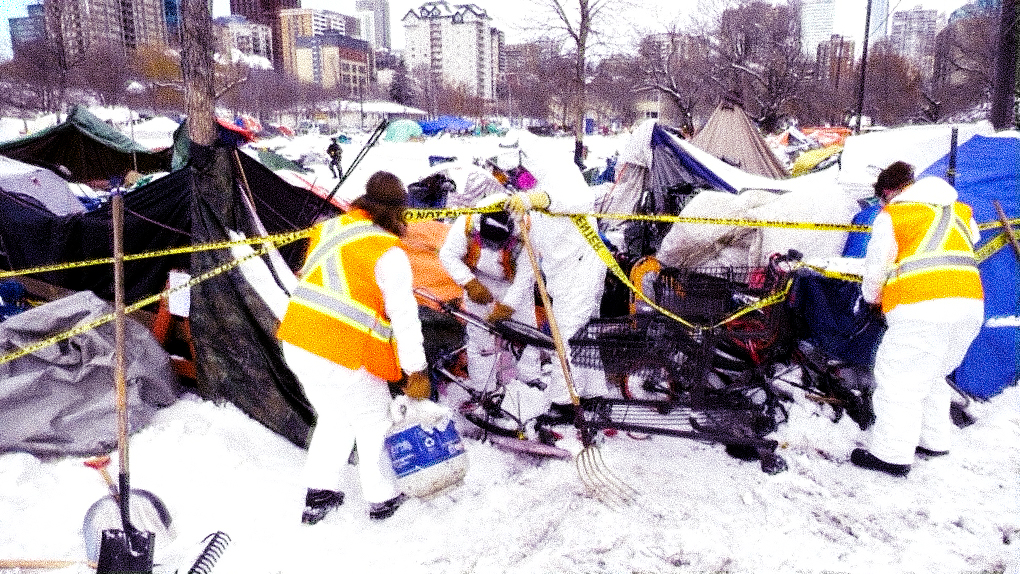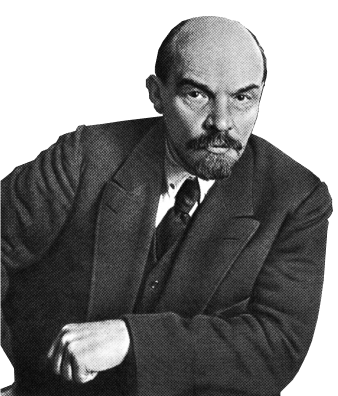
Canada’s homeless are at massive risk of being infected with COVID-19 in cramped shelters. They are suffering immensely in the pandemic. Since the COVID crisis began, homelessness has ballooned all across Canada, and governments everywhere have set their sights on the resulting tent cities. Just as Alberta entered its devastating second wave of COVID-19, the City of Edmonton cracked down on Camp Pekiwewin, a large homeless camp in the Rossdale neighbourhood. On Nov. 8, the City of Edmonton left closure notices at the camp. A few days later, on Nov. 12, city police forced the remaining campers off the site.
Camp Pekiwewin was founded on July 2, as homelessness escalated in the first few months of the pandemic. The camp quickly grew to over 250 residents. Volunteers with first aid and de-escalation training on site provided essential supplies and medical support. A camp organizer, Victoria Guzman, explained that the camp gave residents a safe place to rest without fear of being forcibly removed by the police.
Crisis layered on top of crisis
The pandemic and the economic crash have intensified Edmonton’s already desperate homelessness crisis. Millions of Canadians have been laid off. Thousands of these have been unable to pay their rent and have been thrown out of their homes. These mass evictions have resulted in homeless camps in every major Canadian city.
Contrary to what the more optimistic economists believe, there has been next to no evidence indicating a ‘V’ shaped economic recovery is on the horizon. So far, signs point to what more sober economists are predicting a ‘K’ shaped recovery. Top billionaires keep getting richer, record profits are being reaped by the rich, while the poor continue to suffer. This threatens to throw thousands more onto the streets and intensify Canada’s homelessness crisis even further. Edmonton is no exception to this—quite the opposite. In terms of ‘K’ shaped recovery, it is a contender for the worst city in Canada. Alberta is neck and neck with Québec for highest rate in Canada of per capita active COVID-19 cases, and Edmonton is the worst-hit city in Alberta. Edmonton also tops the charts with the highest unemployment rates of any city in Canada.
Albertan cities also top the charts in mortgage deferral rates. When the federal government allowed homeowners to defer their mortgage payments for up to six months this spring, Edmonton had the highest mortgage deferral rate in Canada, with Calgary coming in a close second. The mortgage deferral period has now ended. People are expected to pay back their deferred payments, with interest. While over half of them have resumed making payments, a significant portion of them have not. Many of these people will be unable to pay, will default on their mortgages, and will be thrown out of their homes.
Edmonton’s homeless population halved from 2008 to 2019, the crisis has already reversed much of this. Since September 2019, Edmonton’s homeless population increased by about 33 per cent from about 1500 people to about 2000 people. Many of those who are newly homeless this year are families and individuals who were dutifully paying their rents and mortgages every month, but have been thrown out of their homes since the crisis. Throughout Canada, many of these people are now inhabiting tent cities.
Why live in a camp?
City officials often talk about homeless camps as if residents choose to live there instead of staying in shelters. Referring to Edmonton’s homeless population and camps in particular, City of Edmonton Interim City Manager Adam Laughlin said, “approximately 1900 people are homeless and of that number, 500–600 choose not to use shelter facilities and camp outdoors illegally every night.”
But Laughlin and other officials know exactly why people really choose to sleep in camps. A 2019 report to the city highlighted that homeless people often prefer camps to shelters, because of the low quality of shelter services. They fear violence and theft in shelters. This is especially true for those who are LGBT, who face harassment and discrimination in shelters.
Of course camp life comes with significant challenges. In the age of the pandemic there is the lack of running water, which makes observing proper hygiene procedures impossible. The fact that many people prefer the hardships of camp life only highlights traditional shelters’ complete inability to satisfy many homeless peoples’ physical, social, and psychological needs. In his statement, Laughlin himself actually described why many residents prefer camp life over shelter life. He said, “Outdoor encampments offer autonomy, an ability to set up a sense of community with others and a connection to the land that life in the shelter system does not provide.” To this we might add: increased safety from police violence, harm reduction services for drug users, and greater acceptance for marginalized people.
The City’s “10 week plan to end homelessness”
After receiving a barrage of complaints about homelessness, Edmonton City Council decided to take action. Referring to the plight of the homeless, Edmonton City Councillor Scott McKeen aptly captured the severity of the situation when he said, “This is a catastrophe within a pandemic within a crisis.”
Edmonton Mayor Don Iveson said we need to “call a spade a spade” and admit that Edmonton has a homelessness emergency. His website estimated on Oct. 10 that 2,000 people in Edmonton are experiencing homelessness, and 600 of these sleep unsheltered on any given night. Iveson correctly explained that, with winter fast approaching, addressing homelessness was urgent. To address the homelessness emergency, Iveson proposed an ambitious “10 week plan to end homelessness.”
Camp organizers were cautiously supportive of Iveson’s goal. They agreed to cooperate with the plan, and announced they would voluntarily wind down the site. But they put forward their own demands and pointed out that the city’s plan would not go far enough. They put forward the need for things like free transit to reduce the economic pressures that push people into poverty. For some, the cost of a $100 bus pass is the difference between making rent and being thrown out onto the street. Free public transit would not only benefit the homeless, but everyone who relies on public transit.
Although Edmonton’s homeless population has been cut in half in the past decade, the City of Edmonton has a track record of promising to eradicate homelessness and then missing the mark. Iveson himself has promised to end homelessness for years. Shelters have slashed capacity due to the pandemic, so shelter space is at a premium. But even with such limited space, the city closed the temporary shelter at the Edmonton Expo Centre when they ran out of provincial funding in July. They had no plans for a replacement. Closing this shelter turned hundreds out onto the streets.
But while Mayor Iveson isn’t willing to fund homeless shelters without help from the province, in summer 2016 he was perfectly happy to give millions to build a new hockey arena, which pushed homeless people out of the downtown area. And rather than make transit free, as Pekiwewin organizers rightly suggested, in 2019 Edmonton City Council quashed a proposal for free transit, and cut the number of bus routes in half. This February, they also nearly doubled the cost of transit passes for already-hurting seniors, and raised fares for everyone. It’s clear that the priority of the City government is attracting investment, and balanced budgets—not helping the poor and oppressed.
Put simply, camp organizers were skeptical because they’ve been burned before. Still, they rightly pointed out that the City government had the chance to turn over a new leaf and make things right this time. The City’s plan boils down to this: Open a new temporary shelter to house Edmonton’s homeless, and continue appealing to the federal and provincial governments to help fund new affordable housing projects, to be used to house those temporarily living in shelters. But even if Iveson achieves everything he dreams of by convincing Jason Kenney to give $17.4 million a year, and Prime Minister Justin Trudeau to give $3.5 billion—it’s doubtful Iveson can achieve his lofty goal. First of all, it’s unlikely new housing projects could be completed before the plan’s deadline, now only two weeks away. These projects realistically could not even be finished before the Conference Centre shelter closes in March. Before it can break ground, any construction project needs to be planned and funded. But planning a new project can take years, and any new federal funds would have to be allotted before the new federal budget in spring 2021.
But Iveson’s plan did achieve one of its aims: the much-needed 24/7 shelter at the Convention Centre opened in late October as planned. Of course, as Iveson’s plan explained, shelters can’t end homelessness. Homeless people sleeping in shelters are still classified as homeless. Shelter services are, at best, a short-term measure to be used while a person is transitioning to more long-term affordable housing.
Mayor Iveson’s website describes the shelter’s goals: “It will provide temporary, 24-7 accommodation with day programming and meal service until March 2021. This 24/7 element is key, because it gives residents a place to self-isolate—normally shelters ask that folks leave in the morning.” When they shut down Camp Pekiwewin, the City of Edmonton arranged for a special bus route and bus tickets to get camp residents to this new Edmonton Convention Centre shelter. Explaining why they closed the camp, city officials brought up the very real risk of freezing to death in the winter. They cried crocodile tears, insisting camp residents would be “safer” at the Convention Centre. But because they feared being infected with COVID-19 at an overcrowded Edmonton Convention Centre, many Camp Pekiwewin residents did not want to move to there, preferring to take their chances on the streets.
They were right to be concerned. Contrary to the city government’s promises of a safe environment at the Convention Centre, residents report that it is actually extremely unsafe. Although the Convention Centre shelter has provided some spaces to self-isolate, this hasn’t stopped the cramped conditions and weak COVID-19 measures from causing an outbreak in late November. By Dec. 2, an astonishing 60 people were infected with COVID-19. Referring to the outbreak and conditions in the shelter, resident Ben Young said, “I would be shocked if everyone in that building didn’t have it at one point or right now. It’s completely unsafe there. It’s horrible.”
The outbreak at the Edmonton Conference Centre forced the city to slash the shelter’s capacity from 300 people at night and 400 in the day, to just 165 people. Iveson’s website reported that 600 people slept on the streets in Edmonton on any given night, so the existing 300 beds were probably already insufficient. And with capacity being slashed, another 135 people were pushed out onto the streets! With such an inadequate effort from the City, “end homelessness in 10 weeks” was dead on arrival. The truth is that the City Council had little interest in seriously addressing the homelessness crisis until it started getting public complaints and criticisms about homeless camps. When they finally acted they did the bare minimum.
End homelessness!
Because travel has been almost totally eradicated in the pandemic, thousands of hotel rooms are sitting empty. In March, Calgary Mayor Naheed Nenshi put two and two together, and proposed housing homeless people in hotels. Scandalously however, the Alberta UCP government blocked this proposal, citing cost. But even if the current homeless population were moved into empty hotel rooms, this is not a long term solution. Nobody can live a decent life in a hotel room indefinitely, and more people are still becoming homeless. To stop this increase in homelessness, rent increases and evictions must be halted.
The truth is that the problem is not a lack of housing. The problem is that this housing is privately owned. Homelessness could be abolished in a very short period of time. Just last year Edmonton had more than 5300 empty homes and only 2000 homeless people. This means the government could give every homeless person in Edmonton 2.75 homes. But since many of these houses are currently “in use” as vehicles for financial speculation, and since the motto of capitalist governments is “profits over people”, they won’t dare touch these empty homes. They are happy to accept any amount of suffering so long as the profits keep flowing.
A society that allocated resources rationally, for the needs of people rather than profit could set to work eradicating unemployment and homelessness. Empty homes and hotels would be put to use to house the homeless, and unemployed people could be given jobs building high-quality social housing. In this way, we could guarantee every person a safe home, eradicate hunger and oppression, and guarantee a decent life to all. The obstacle that stands in the way of achieving these goals is this rotten capitalist system which allows homeless people to freeze to death next to empty homes.

